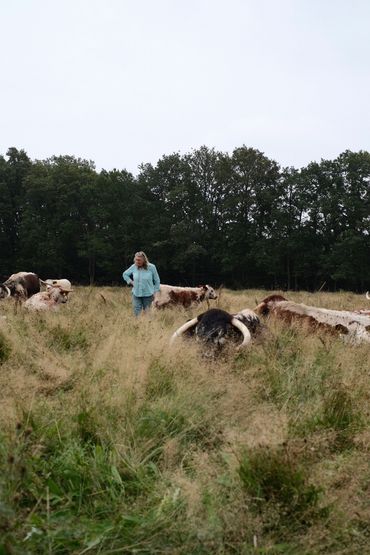Moat Farm
Signed in as:
filler@godaddy.com
Moat Farm
Signed in as:
filler@godaddy.com

We purchased Moat Farm, Shadoxhurst in 1986. At that time it was a grass farm of 90 acres with 50 acres of semi natural ancient woodland. Over the years we have purchased surrounding fields and woodland, and that drew us to simply concentrating on the natural features, including over 25 Wealden ponds. We decided to focus on conservation farming, having noted more and more the remarkable levels of biodiversity in this part of the Low Weald.
In 2007 the opportunity arose to buy 90 acres of immediately adjacent woodland, which had been neglected for several decades and shortly after that another 60 acres of unimproved meadows were added on the southern boundary of the farm. This created the layout of the farm today with 160 acres semi natural ancient woodland, 60 acres of species rich wet grassland, and 30 acres of permanent pasture reverting to wildflower meadows. We also purchased an 8 acre field immediately adjoining our northern boundary with neighbours. This field is also becoming species rich. In the first spring of the new meadows, we were excited to identify about 20 spikes of Common Spotted Orchids together with significant numbers of sedges and other wild flowers through the summer including Bugle, Trefoils and Vetches.
This prompted consultation with Kent Wildlife Trust and Natural England. We immediately embarked on management techniques to improve connectivity through the closed canopy woodlands and to enhance and re-establish the wildflower meadows throughout the farm.
The previously derelict woodlands have come to life with wonderful showings of White Admiral and Silver-Washed Fritillary in the woodland rides. To date, we have noted 26 species of butterfly around the farm and its woodlands. Dormice and Harvest Mice are regularly encountered.
The wildflower meadows have become a particular joy. Management by grazing and late mowing for hay has increased the Common Spotted Orchid population in one field, to now having many hundreds of spikes and orchids now appearing throughout that block of land. Yellow Rattle has also rapidly become established and there is abundant knapweed, fleabane, and other high nectar producing plants which host clouds of butterflies on hot summer days. Marbled White are numerous alongside Ringlet, the common Browns, small Coppers, Blues, Skippers and so on. Grizzled Skippers were seen regularly on the Alex Farm Pastures (see below) but the last two summers give rise to concern, with no sightings.
Purple Hairstreak is numerous in the tops of the oak trees. In the original area of the farm, the meadows are naturalising, with Yellow Rattle increasing, and even one single spike of Green-Winged Orchid alongside an increasing scatter of Common Spotted. Early Purple is in small colonies across the farm and woodland.
Birdlife is abundant. Three broods of Barn Owls were raised in 2018 and one brood of Kestrels. Buzzards nest in the woodland and there is a good population of Tawny Owl. We are currently hosting a Little Owl project for a student from Kent University.
One of the jewels in the crown of the Woodland Management Scheme is the Nightingale population. Five Nightingales held territory in 2018 on Alex Farm Pastures and approximately seven held territory on our own farm.
This area is rich in plant life including Adder’s Tongue, Dyer’s Greenweed, Common Spotted Orchids, Betony and Devil’s Bit Scabious amongst others. We were able to facilitate the purchase of this area by a conservationist in the village and our Stewardship Scheme continues in cooperation with the new owners. We also regularly hear Turtle Dove, but never located a nest. We feel lucky to have identified the biodiversity potential of this farm.
We now have a Shepherd’s Hut on the farm as well as two Bell Tents where visitors are free to ramble through the woods and meadows or we can take them on targeted walks if they so wish. We have also held small blessings in the fields and woodlands with the use of a rustically renovated barn.
We host events for the Ashford Mayor, Weald of Kent Protection Society and numbers of private visits. We are particularly concerned at the lack of protection for the Low Weald and are actively trying to highlight its exceptional features whilst remaining aware of the need to control disturbance.
The area is also renowned for moths, which are regularly counted during summer months with numerous rarities identified.
The Wealden ponds contain a good population of Great Crested Newt. We also have Three-Lobed Water-Crowfoot, which is rare nationally and which we have managed to enhance. Good water quality also enables populations of Water Violet, Dropwort etcetera. Seasonal streams run across the farm and feed into the headwaters of the Beult catchment. This accounts for two small colonies of Water Voles, which are under pressure from Mink. The local population of toads is remarkable with a massive migration to our ponds for spawning in mid-March. Frogs, Grass Snakes, common Lizards and Slow Worms are regularly sighted.
Over half of the farm is within the Orlestone Woods & Pastures Local Wildlife Site. Alex Farm Pastures is a Site of Special Scientific Interest. There are Tree Preservation Orders on part of the woodland.



-af7bd4d.jpg/:/rs=w:370,cg:true,m)



.jpg/:/rs=w:370,cg:true,m)

.jpg/:/rs=w:370,cg:true,m)

.jpg/:/rs=w:370,cg:true,m)